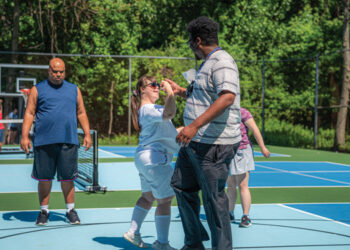How two facilities are keeping the kids in their communities engaged via childcare and after-school programs.
The coronavirus pandemic turned the world upside down. With businesses closed, schools going virtual and a plethora of regulations in place, community rec centers showed up to provide their communities with crucial offerings.
One of the most important was childcare.
While the past year looked different than before, childcare and after-school programs continue to be a familiar place where children can be safe, active and engaged during their time out of school — something especially important as children adjusted to the many changes related to COVID-19.
One facility that continued to serve the children in their area was the Gateway Region YMCA in St. Louis, Missouri — the largest provider of childcare in the area.
“It’s important for us to fill in the gaps where there are needs,” said Laurie McTearnen, the vice president of association childcare, day camp and inclusion services at the Gateway Region Y. “At the Y, we offer early childhood education, and before and after-school programs known as Y Club. It gives parents the comfort knowing their children are in good hands.”
The YMCA provides before and after-school programming for over 4,100 children daily, partnering with 23 school districts, as well as public, private and charter schools. They have many curriculum-based activities they use to program a well-balanced day and keep children engaged. Additionally, the Y staff ensures their before and after-school participants are getting assigned schoolwork done.
“Out of the variety of programs offered, we tend to see our participants really draw toward STEM activities, art, outdoor recreation, card and board games, and reading,” said McTearnen. “Being creative and thinking outside of the box is always a winner.”
Paul Isserles, the associate executive director of the Sid Jacobson JCC in East Hills, New York, agreed creativity is essential when it comes to childcare and after-school programs.
The JCC’s after-school programs offer families the ability to enroll in both traditional childcare that focuses on homework help and recreational activities, or enrichment classes such as sports, science, arts, theater and more.
“To provide a high-quality program, it is important for staff to put in the necessary time to build a curriculum that is engaging for the children,” said Isserles. “This is critical for all childcare programs, but especially ones with enrichment courses like ours.”
The JCC offers both in-house childcare programs, as well as in two outside school districts. Pre-COVID, they served over 250 children throughout all of the different programs. According to Isserles, parents are always in need of high-quality, professional childcare for their children. It is a great program to offer families to give them a program that meets their needs, as well as a way to connect families to your organization.
“Childcare is a wonderful program that can be revenue-producing as well as mission-driven,” said Isserles. “Like everything else, it is imperative to find the right professional to run the program and the staff to work hands-on with the children.”
A great way to make sure your staff is prepared to best serve the children in your facility is through proper planning.
The Gateway Region Y staff plans weekly and monthly for the activities based upon their curriculum outline. They provide staff on average two hours per week to review plans, outline activities, update weekly activity calendars and order any specific items needed to implement the plans.
While it’s no secret childcare and after-school programs are staples for community centers, there is always room to improve. Start by making sure your offerings are diverse.
“While academic support and enrichment is an important component, it should also be complemented to provide equal distribution of letting children be children, encourage social engagement, create self-independence, promote health and wellness, and build conflict resolution skills,” said McTearnen. “It’s also important to always provide opportunities for open communication and activities that strengthen and support the family unit. Collaboration and partnerships are critical to having a successful program.”










